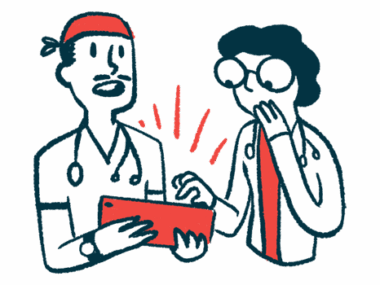The 5 Questions I’m Most Frequently Asked About Porphyria
Written by |

Four years ago, I was diagnosed with acute hepatic porphyria (AHP), and it’s complicated. It’s a liver disease affecting my blood; it’s also an inherited metabolic disorder with neurovisceral effects. I’m still figuring out how to dumb down the mechanics.
For this column, let’s skip the medical jargon. Porphyria Awareness Week is coming up April 10-17. And in the spirit of painting the world purple (that’s the advocacy color of porphyria, in case you didn’t know), following are answers to the five questions I’m most frequently asked about life with AHP.
1. How rare is AHP?
AHP can affect anyone, regardless of skin color, sex, or age, but the majority of those diagnosed are women between the ages of 15 and 45. In fact, four in five people with AHP are women. AHP affects an estimated 10 in every 1 million people. Most people with the gene mutation will never know it, as fewer than 10% develop symptoms.
I live with acute intermittent porphyria, the most common type of AHP. My dad and brother both have latent porphyria, meaning they tested positive for a gene causing AHP, but have yet to experience any symptoms. Knowing their predisposition, they are able to live in caution, avoiding triggers that could lead to an attack.
2. What is a porphyria attack, and what are the causes?
Imagine taking your body to the all-you-can-eat symptom buffet and sampling a little bit from each dish. That’s what an acute porphyria attack is like.
It affects the peripheral, autonomic, and central nervous systems, the gastrointestinal tract, and the cardiovascular system. People with certain forms of porphyria will experience lesions or blisters on sun-exposed skin. Porphyria attacks can be life-threatening and last for days. Without proper treatment, I’ve been in crisis for weeks at a time.
Hormones, medications, fasting, stress, viruses, and alcohol can provoke severe symptoms. But just as everyone with AHP experiences attacks differently, the effects of triggers vary from person to person.
For instance, I can rely on my cycle to dictate my symptoms on any given month. I know that every few weeks my discomfort will increase and subside along with fluctuating hormones. I’m also highly sensitive to the impacts of stress, which is why self-care is my secret weapon.
At this point in my life, my symptom pattern is fairly predictable. Constipation is an early warning sign that things are ramping up, followed by insomnia and unspecified anxiety. Next come hip and leg pain and weakness, followed closely by the hallmark acute porphyria symptom, unexplained severe abdominal pain.
AHP abdominal pain is like something out of my worst nightmare. It can feel like a thousand flaming swords, like an alien trying to bust out of my gut, and like someone has kicked me in the stomach repeatedly, all in a span of seconds.
One of the biggest misconceptions about the abdominal pain is that it’s related to gastrointestinal symptoms, but anyone with AHP will tell you otherwise. This is not an upset stomach, nor is it a cramp or bloating. It is next-level pain.
3. Do you only experience pain during an attack?
I don’t use the word “intermittent” to describe my symptoms. I live with chronic bone pain, which sinks its teeth into my neck and shoulders daily. Insomnia, constipation, and migraines are additional day-to-day challenges I experience between attacks.
4. Is there a treatment?
Approximately 95% of rare diseases don’t have treatments, but fortunately there are two for AHP. Panhematin (hemin for injection) can treat attacks, and Givlaari (givosiran) can prevent them. Neither of these treatments are cures, and they may not be appropriate for everyone with AHP.
If you are experiencing AHP symptoms, talk to your doctor or visit a porphyria specialist to learn which treatment may be right for you. When I received my diagnosis, I thought treatment would help me feel normal again, but I have since learned that there’s no such thing.
5. Could I have AHP?
I’m not a doctor, but am asked this question regularly. Certainly, there are people with undiagnosed AHP walking around scared, questioning their symptoms, and suffering in pain. Not only is awareness of this rare condition a problem for diagnosis, but also the wide variety of symptoms make it difficult for a single specialist to connect all the dots. Plus, AHP can resemble many other conditions, including endometriosis, Crohn’s disease, Guillain-Barré syndrome, multiple sclerosis, and gallbladder disease.
If you think you may have AHP, talk to your medical provider. For help with advocacy and diagnosis, contact the American Porphyria Foundation.
***
Note: Porphyria News is strictly a news and information website about the disease. It does not provide medical advice, diagnosis, or treatment. This content is not intended to be a substitute for professional medical advice, diagnosis, or treatment. Always seek the advice of your physician or other qualified health provider with any questions you may have regarding a medical condition. Never disregard professional medical advice or delay in seeking it because of something you have read on this website. The opinions expressed in this column are not those of Porphyria News or its parent company, Bionews, and are intended to spark discussion about issues pertaining to porphyria.






Leave a comment
Fill in the required fields to post. Your email address will not be published.